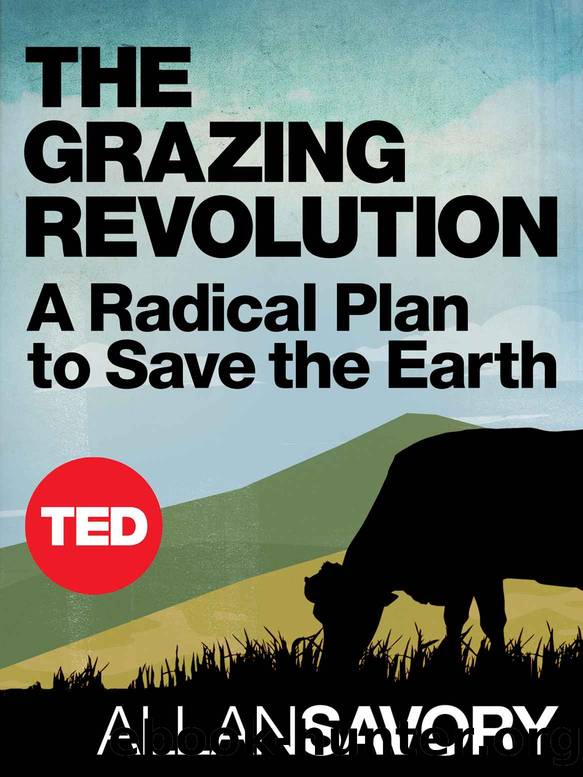The Grazing Revolution: A Radical Plan to Save the Earth (TED Books) by Savory Allan

Author:Savory, Allan [Savory, Allan]
Language: eng
Format: epub
ISBN: 9781937382391
Publisher: TED Conferences
Published: 2013-12-11T00:00:00+00:00
Holistic planned grazing in brief
The holistic planned grazing process begins by clearly defining the context for the many objectives in management. In this case, it is a holistic context. This is opposed to the context we find for objectives in management, most commonly need, desire, profit, or addressing a problem. These contexts are too simplistic and donât take into account the social, environmental, and economic complexity involved.
A great many factors are considered and the details noted by those doing the planning. What land is available? (For instance, is it owned or leased, and what is owed on it?) Is extra land available in an emergency, and at what cost? What animals are there? Whatâs the best way to divide the land into grazing areas, or paddocks? Should these areas be fenced or merely demarcated by landmarks known to herders? Where will the animals drink, and how can you ensure water supplies are adequate? What weather patterns should you be aware of? (Are there periods of heavy frost? Areas of deep snow? Prevailing winds? Fire threat?) Are there market factors that could influence the type of livestock run? (Year-round cows and calves, or seasonal steers on the gain, a mix of cattle and sheep, sheep and goats?) What specific wildlife needs and considerations have to be incorporated into the plan? (For instance, where do ground-nesting birds nest, what degree of cover is essential for chick survival, and over what months?) What other land uses â crop fields, forestry operations, hunting, ecotourism, game viewing â will affect where and when the livestock can be?
The first thing to consider is what season you are planning for: growing or nongrowing. You create one plan for the growing season, which aims to maximize the amount of forage produced while preventing overgrazing. You create another plan for the nongrowing season, where the aim is to ration out the available forage so it lasts until the next growing season for both livestock and wildlife, while ensuring enough litter remains to make the coming rains effective.
The next step is to set up the grazing planning chart. Across the top of the chart, note the months. Down the left column, chart the grazing areas, or paddocks, and rate them based on their quality and size. Livestock details, including quantity, are recorded on the bottom.
Next, use color coding to demarcate the factors that will influence your plan. Examples include when you expect to breed and wean; when and where areas will be snow covered or at risk of fire; when and where, say, antelope are dropping young and cattle will need to be kept away; when and where you will need herds to trample a bare ground area or a harvested crop field; locations of poisonous plants and times of danger (not all poisonous plants are always dangerous; also, the danger lessens when their leaves constitute a small percentage of total forage available to grazing animals); where there may be water restrictions; and when to expect absences of key people due to vacation, family events, or other commitments.
Download
This site does not store any files on its server. We only index and link to content provided by other sites. Please contact the content providers to delete copyright contents if any and email us, we'll remove relevant links or contents immediately.
Eating Animals by Foer Jonathan Safran(684)
J. M. Coetzee and Ethics by Anton Leist(651)
Cats by Unknown(585)
Tears of Battle by Brigitte Bardot(541)
Rescue Ink by Rescue Ink(505)
Run, Spot, Run: The Ethics of Keeping Pets by Jessica Pierce(410)
Pigs of Paradise by T. R. Todd(403)
Kindness for All Creatures by Sarah C. Beasley & Anam Thubten(396)
Food and Nutrition by Unknown(393)
Simple Recipes for Joy by Sharon Gannon(369)
Wild Horse Annie and the Last of the Mustangs by David Cruise & Alison Griffiths(357)
Veganism, Sex and Politics: Tales of Danger and Pleasure by C. Lou Hamilton(332)
Animals and Women: Feminist Theoretical Explorations by Carol J. Adams & Josephine Donovan(329)
Prison Dog Programs by Mary Renck Jalongo(305)
How to Count Animals, more or less by Shelly Kagan(297)
The Routledge Handbook of Animal Ethics by Bob Fischer;(244)
Making a Killing by Bob Torres(241)
Our Symphony with Animals by Aysha Akhtar(241)
The Joyful Vegan by Colleen Patrick-Goudreau(236)
